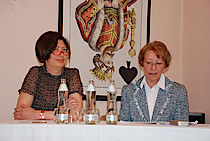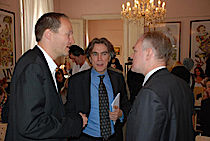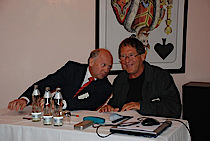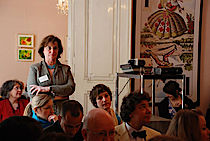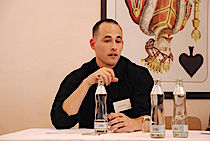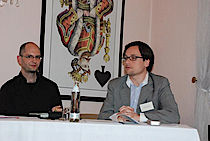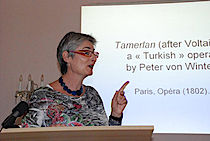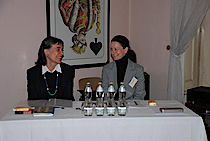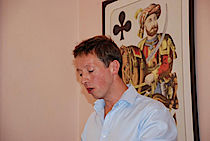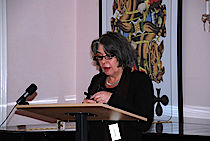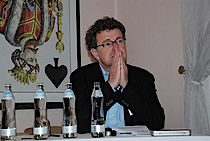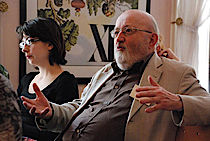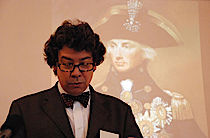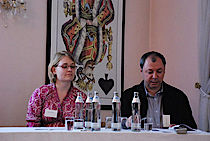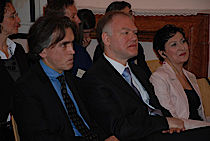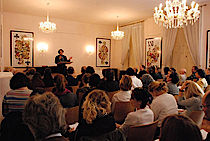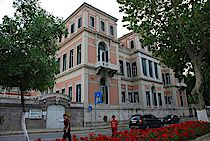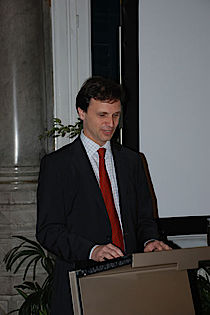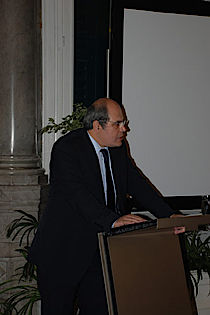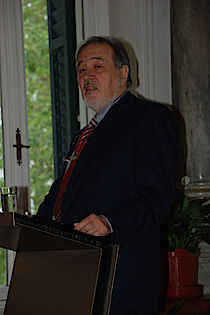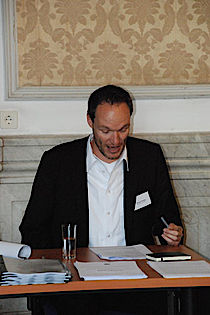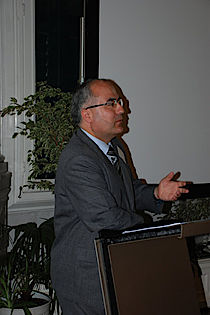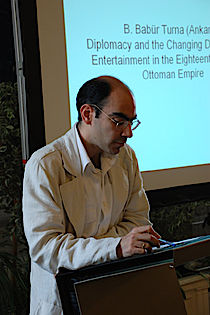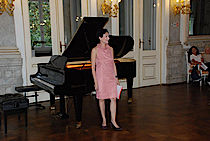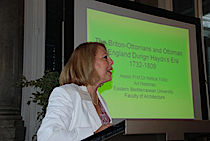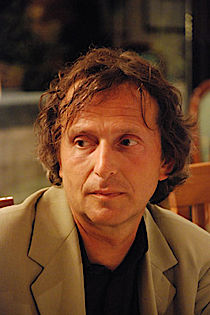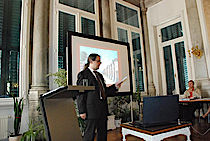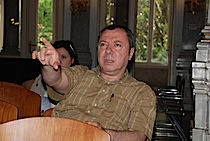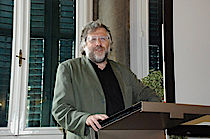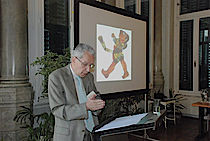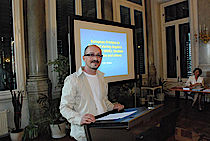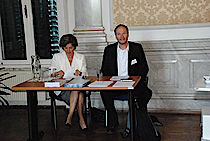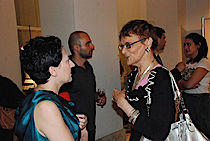Symposium Vienna 2009
Symposium Istanbul 2009
OTTOMAN EMPIRE AND EUROPEAN THEATRE
II.
The Time of Joseph Haydn (1732-1809)
From Sultan Mahmud I to Mahmud II (r.1730-1839)
VIENNA
24TH APRIL 2009, FRIDAY
10:00 Vienna Symposium Opening
including:
Michael Hüttler (Don Juan Archiv Wien)
Selim Yenel (Ambassador of the Republic of Turkey)
Emil Brix (Ambassador, Austrian Foreign Ministry, Cultural Section)
Helga Dostal (ITI-UNESCO Centrum Austria)
10:30 Session I
Speakers:
Bertrand Michael Buchmann (Vienna)
Annemarie Bönsch (Vienna)
1. Bertrand Michael Buchmann (Vienna)
Austria and the Ottoman Empire, 1765-1815
A comparison between the Habsburg Monarchy and the Ottoman Empire during the age of Joseph Haydn shows a picture of two super powers which had had completely different political, economical and societal histories, but which were heading towards the same fate: simultaneous collapse.
The Ottoman Empire had already passed the peak of its power and slipped towards its unstoppable decline. Only its vastness and, not least, the envy of the other major powers saved the 'sick man' from complete annihilation. Austria, by contrast, had just accomplished its rise to super power status, also at the expense of the Ottomans. But its existence was also threatened: twice the Habsburg Monarchy had suffered life-threatening crises, first in 1740-1748 because of the 'War of the Austrian Succession', and second, because of Napoleon in 1809.
Both empires urgently needed to be reformed. The Ottoman reformation period (the 'Tulip period') brought about some short-term military success, but did not have sustainable success, especially as the populace was quite opposed to the reforms. On the other hand, the Austrian reformation period under Maria Theresia and Joseph II brought about substantial innovations for the state, including achievements that can be seen even today. When Joseph Haydn was born, Austria and the Ottoman Empire were still hereditary enemies, but towards the end of his life both states started to form a friendship, which a century later had its peak in the brotherhood in arms of the First World War.
From Aristocratic to Bourgeois Fashion In the Second Half of the Eighteenth Century
The highbrow ideas of Enlightenment come to fruition in the fashion of the second half of the eighteenth century. The bourgeois aspect of the philosophers of the Enlightenment especially sounds the bell for a trend reversal in costume history. This change began within the scope of aristocratic robes, until finally the Empire - with its hellenistic models - turned away from the fashion of the Ancien Régime. Within this frame, the outcome of change in women's fashion was much more efficient than in men's fashion, and there, various threads in the evolution of fashion come together. The fashionable British, as well as the créole or Kreolenhemd, find in the antique chemises a wearable, almost universally appealing silhouette which liberated itself from aristocratic froms of expression.
There have also been decent bourgeois approaches which cannot be manifested by the modern observer as easily as the more striking Empire fashion. This paper will focus on exactly these hidden signals of a bourgeois society.
12:00 Coffee break
12:15 Session II
Chair: Helga Dostal (Vienna)
Speakers:
Tülay Artan (Istanbul)
Adam Mestyan (Budapest)
Eighteenth-Century Bosphorus as a Theatre of Life
The Bosphorus, the narrow strait that runs a winding course between Asia and Europe, connecting the Black Sea (Pontus Euxinus) to the Marmara Sea (Propontis), has gained a timeless attribute in the secondary literature on the history of Istanbul. While the hills rising behind its two shores are often described as amphitheatres looking onto one another, covered with woods, vineyards and orchards, the shore line is praised for being adorned with delicate waterfront mansions, palaces, and small villages where fishermen and gardeners mingled with the religious elite, statesmen and princesses. All this has been conceived as a condition of the eighteenth-century 'Ottoman Bosphorus', a preplanned enterprise of the court society.
This paper will elaborate on the summer night concerts organized by the elite which became spectacular public events with musicians on rowboats sailing along the current in the light of candles and torches, and it will discuss the critical junctures in the development of the Bosphorus into a stage set in the second half of the eighteenth century using historical records, both narrative and visual. It will focus on the activities Ottomans pursued during their moments of recreation and the meaning that this theatre had in their lives.
Muhammad Ali (Mehmet Ali Paşa), Vice King of Egypt (1805-1848) and European Music
Muhammad Ali (Mehmet Ali Paşa, Kavala 1769-1849 Alexandria) ruled Egypt from 1805 to 1848 as an Albania-born Ottoman Turkish military officer and wali (governor, vice king). He initiated land reforms, reorganized the military, and made successful military campaigns in the Arab peninsula, in Syria, and in the Sudan. He also wanted to establish his own dynasty in Egypt. Although in mainstream Egyptian historiography he is still considered to be the 'Father of Egypt', it is clear that his main concern was securing his own power (see for instance, the studies by Khaled Fahmy).
His rule is also the period when the first and second waves of Italian and French immigrants and travellers arrived in the country. Muhammad Ali used European experts to modernize the army, to reorganize the infrastructure of the country, and finally to build new palaces for his and his family's own use. This is the context in which European style music and fine arts were presented in Egypt for the ruler. New, European fashions (uniforms, music, luxury gifts) were used in traditional public and private ceremonies. One of these occasions, a princely marriage in 1841 (or 1842), is the first known event when European operas were offered to entertain the ruler. My presentation discovers the historical circumstances of this special occasion and its significance in the nineteenth-century history of Arabic music and theatre.
13:45 Lunch break
15:00 Session III
Chair: Michele Calella (Vienna)
Speakers:
Daniel Winkler (Vienna)
Isabelle Moindrot (Tours)
Zaire: Colonialism, Love and Enlightenment: Voltaire's 'Popular' Theater of the 1730s and 1740s
Voltaire (Françoise Marie Arouet, 1694-1778) wrote many tragedies which followed in form and subject matter the traditions of the classical era. But with his exile in Great Britain (1726-1728) he began to write a series of pieces with female protagonists that deal with matters of colonialism, exoticism and love.
The first and most successful of these tragedies is Zaïre (1732), set in a harem in Jerusalem, where the protagonist is confronted with her love for the Muslim Sultan Orosman and her Catholic crusader family who reigned over the city several decades before. While set in the Middle Ages (after the first crusade, 1096-1099), the tragedy deals with aesthetic and ethical questions of the eighteenth century. As far as concerns the form of tragedy, Zaïre remains rather traditional, but Voltaire clearly wants to renew the genre in terms of politics and its dramatic dynamic. Voltaire describes the 'oriental' Orosman as 'enlightened' and tolerant while the Christians, like Zaïre's father Lusignan and her brother Nerestan, are marked as rather negative and dogmatic characters. The main characters and the topics of imperialism, intrigue and intercultural love are clearly marked by intertextual references to Shakespeare's Othello. But the similarities are not only between the cross-cultural background of the story plots and the two protagonists, Zaire/Desdemona and Orosmane/Othello, but also between the dramatic dynamics of the pieces, especially in the final two acts.
Zaïre is Voltaire's first tragedy which puts a love story at the centre. For him, generally speaking, the love question did not stand in the foreground of the genre of tragedy. He introduced this aspect for the better identification of the public with his characters and to heighten the chances of success of his pieces. He wanted to construct himself as the foremost tragedian and to displace the authors of the classical era such as Pierre Corneille (1606-1684) and Jean Racine (1639-1699) from the repertory of the Comédie Française. In this respect, exoticism and love played important roles and also influenced the conception of further tragedies with female protagonists and 'exotic' settings such as Alzire (1736), Zulime (1740), and Sémiramis (1748). Some of these were also adopted for opera by a wide range of librettists and composers of the late eighteenth and nineteenth centuries. To put it briefly, Zaïre will be analysed with regard to this popular and 'commercial' aspect of Voltaire's theatre.
Tamerlan (1802): A French Opera after Voltaire by Peter von Winter
Tamerlan, an opera in three acts by Peter von Winter (1754-1825), was created in Paris in 1802 (27 fructidor an 10), on a libretto by Étienne Morel de Chédeville, after Voltaire. If the title Tamerlan seems to refer to a very operatic subject (cf. the many operas adapted from Nicola Pradon's [1632-1698] tragedy Tamerlan ou la mort de Bajazet [1675] throughout the eighteenth century), Morel de Chédeville (author of La Caravane du Caire [1783] by André Grétry [1741-1813]), took his inspiration from L'Orphelin de la Chine (1755) by Voltaire. The paper will concentrate on the long-lasting influence of Voltaire on the 'Ottoman subject', and on the cultural and artistic context of the 1802 Paris performance of Peter von Winter's French opera.
17:30 Evening Program: Haydnhaus
(Guided tour for participants to Joseph Haydn's last residence)
25TH APRIL 2009, SATURDAY
10:00 Session IV
Chair: Gabriele C. Pfeiffer (Vienna)
Speakers:
Necla Çıkıgil (Ankara)
Matthew Head (London)
Käthe Springer-Dissmann (Vienna)
Haydn's Humour Reflected in Lo Speziale (1768) and in L'incontro improvviso (1775)
Haydn's parish schooling in the 1730s, his work with the comic actor Joseph Felix von Kurz (Bernardon, 1717-1784) in the 1750s, and his associations with the learned authorities in the Grenier salon in the 1770s and 1780s were all very different experiences that influenced his versatility in his musical creations. This versatility manifested itself especially in his comic operas, Lo Speziale and L'incontro improvviso. In these operas is also reflected Haydn's little known humorous temperament. The comic elements in these operas can be traced back to ancient Greek and Roman comedies, and to the sixteenth and seventeenth-century commedia dell'arte tradition. To aid the reflection of his humorous temperament, Haydn makes use of the 'Turkish' motifs that were so frequently employed by various composers such as Mozart and Beethoven. This paper will discuss how these comic elements emerged and how the 'Turkish' motifs allow the appearance of 'Humorous Haydn', following Scott Burnham's discussion in Haydn and Humor.
2. Matthew Head (London)
Interpreting Haydn: Critical Frameworks for Enlightenment, Exoticism and L'incontro improvviso (1775)
What is the meaning of Haydn's Turkish exoticism, considered at the musical and, more broadly, theatrical levels? What interpretive frameworks are available - and what are yet to be imagined - in dealing with Austrian 'Turkish' opera, stage works, and instrumental music of the later Enlightenment? This paper reviews the recent history of interpreting late eighteenth-century exoticism. Musical exoticism emerged as a 'hot topic' in the 1990s in large part because of the 'orientalism debate' in literary and cultural studies (relating to Edward Said's diagnosis of scholarly discourse on the Middle East in his Orientalism [1978] as a textual regime of power/knowledge involving a binary opposition of Self and Other). But the politicisation of musical exoticism (involving such issues as identity, power, and the politics of cross-cultural representation) was so at odds with musicological practices that much of the critical energy of the 'orientalism debate' was quickly neutralised in studies that domesticated the topic to enduring humanist/positivist frameworks of interpretation: the chronological survey of repertory, the description of compositional techniques (rather than meanings), the facts and figures of a work's genesis and first performance.
This is not to argue, however, that a hyper-Saidian approach to such a work as L'incontro improvviso is preferable. The challenge lies, rather, in combining critical frameworks and in tracing the multiple levels on which this work was meaningful in its historical context. The exoticisation of opera through the 'Turkish' setting in L'incontro improvviso was related (in somewhat contradictory ways) to multiple sites of meaning. The distinction between Self and Other is not only destabilized by the theatrical practices of disguise and mimicry, but also by the double origin of 'Turkish' exoticism in the Austrian military defeat of the Ottoman forces in Europe, on the one hand, and on the other, the French courtly practice of including 'Turkey' within the discourse of Europe for the purposes of bolstering diplomatic links with the Sublime Porte. The roles of exoticism as a masked critique of home institutions (for example, the clergy) and character traits (over-refinement) represent another aspect of the meaning of exoticism in L'incontro - a particularly important aspect in this period when critique and censorship were pursued with equal vigour. Enlightenment rhetorics of brotherhood across boundaries of social position and nation, and of tolerance for cultural difference also inform the meaning of exoticism in L'incontro improvviso. The Viennese origins of the work and the circumstances of its first performance alert us to another level of meaning. With a libretto based on an earlier Viennese 'Turkish' opera by C. W. Gluck (a darling of the court-run Burgtheatre), L'incontro was first performed in the Esterhazy court of Prince Nikolaus as part of the festival entertainments honouring the visit of Archduke Ferdinand and his consort Maria Beatrice d'Este (August, 1775). If L'incontro seized on a no longer threatening Ottoman culture as an occasion for imaginative escape and sensory enchantment, it also testified to the century-long process of Habsburg cultural colonisation of the Hungarian nobility that followed the expulsion of the Turks from central European territory.
3. Käthe Springer-Dissmann (Vienna)
Did Mozart drive a 'Haydn'? Cartwrights, Carriages and the Postal-System in the Austrian-Hungarian Border Area
In the course of their first trip to Vienna (September 18, 1762 - January 5, 1763) the Mozarts went to Pressburg, at that time the capital of Hungary, where Wolfgang and his sister Maria Anna ('Nannerl') played for the Hungarian aristocracy. Little is known about this visit that lasted from December 11 to 24, 1762, and took place at the request of the Hungarian aristocracy, according to Leopold Mozart's letter to Lorenz Hagenauer on December 10, 1762. But at least Leopold has informed us about their mode of travel. Worried about the health of his family in the cold season and the bad conditions of the streets, he decided to buy a well-sprung, covered carriage for four in Pressburg. Such a private carriage was not only far more comfortable than the mail coach, but was also considered a status symbol. In any case, it brought the family safely to Vienna (travelling time: twelve hours) and from there home to Salzburg, having left Vienna on December 31, 1762. Half a year later the Mozarts used it for their grand tour of western Europe (1763-1766), which took them as far as London, twenty-five years before Haydn arrived there.
This carriage may in fact be an indirect link between Mozart and Haydn. Living in the border area next to the Apostolic Kingdom of Hungary, the Haydns had worked successfully as cartwrights for two generations until the sons Joseph, Michael and Johann left the family business and dedicated themselves to music. It is likely that many carriages used in the eastern corner of Lower Austria and across the Hungarian border, including Pressburg, came from the workshops of this widespread family (only in 1758 did a law enacted by Maria Theresia forbid the profession of cartwright to be the exclusive domain of certain craft families). So the first carriage the Mozarts owned may well have been a 'Haydn'.
Starting from this Haydn family background, which remained influential throughout Joseph's life, we will outline a short history of the use of carriages, a history that coincidentally had its roots in this region in the western Hungarian village of Kócs where the famous early (or for some, the earliest) coaches were produced (hung. kocsi szekér = 'cart of Kócs'), and from where the term coach (Germ. Kutsche, Span. coche, Ital. cocchio etc.) presumably derives. Coaches were first mentioned in 1487. Three years later, the postal system was established in the Holy Roman Empire by Maximilian I, at first carried out by messengers on horseback, but finally creating the conditions for the regular coach and postal traffic in the eighteenth century. It made Mozart's Europe-wide journeys possible, as we showed last year, and it also facilitated Joseph Haydn's travels and correspondence. It is with reference to the latter during Haydn's long service to the Hungarian princes of Eszterházy that this presentation will consider the development of the Hungarian postal system, a development that took place under the impact of the wars between the Habsburg and Ottoman Empires. It will show, too, the mail and travel connections between Vienna, Eisenstadt, Eszterház and Pressburg as Haydn's main destinations in his Hungarian period.
12:15 Lunch break
14:00 Session V
Chair: Stefan Hulfeld (Vienna)
Speakers:
Geoffrey Roper (London)
Reinhard Buchberger (Vienna)
Music, Drama and Orientalism in Print: Joseph von Kurzböck, his Predecessors and Contemporaries
The Viennese printer and publisher Joseph Lorenz Ritter von Kurzböck (1736-1792), also known sometimes as Kurzbeck, took over his father's printing house in 1755. He excelled in several spheres of fine printing, notably music - he published many of the works of Joseph Haydn, as well as of lesser known operatic and other composers - and the literature of the Enlightenment. According to Durstmüller, he was, after Johann von Trattner, "Der zweite grosse Druckherr im Theresianischen Wien". At an early stage he developed connections with the Orientalische Akademie, founded in 1754. Partly to serve the needs of this institution, he set up in 1770 what he called his "Illyrisch- und orientalische Hofbuchdruckerey". In the following twenty years, he printed a series of Arabic, Persian and Turkish texts, using Arabic types specially created by himself, with the help of, among others, Yusuf Sasati, an Ottoman Syrian tradesman living in Vienna.
This paper seeks to elucidate the musical/dramatical and Orientalist strands of Kurzböck's career, and to consider to what extent they were related. At the same time it will consider, by way of background and comparison, some earlier and contemporary Orientalist printers in Europe, and the birth of Ottoman printing in the eighteenth century.
2. Reinhard Buchberger (Vienna)
The Austro-Turkish War of 1788-1791 as Reflected in the Library of the Viennese Bibliophile Collector Max von Portheim
Max von Portheim (1857-1937) was one of the most significant characters in the Viennese bibliophile circles of his time. His library of about 25,000 volumes was built around the personality of Emperor Joseph II (1741-1790) and his reign; on a wider scale we could say it was built around the whole Age of Enlightenment in Austria. But his library was not meant to be just a collection. Max von Portheim used his books, among other sources, to create an enormous index of about 450,000 handwritten cards, producing in a way a paper-based, bio-bibliographic data base of all kinds of aspects of the Josephinian Age. Today Portheim's library and his card catalogue are stored at the Vienna City Library (Wienbibliothek im Rathaus, former Wiener Stadt- und Landesbibliothek).
Besides books about travels to the Ottoman Empire and alla Turca-style plays, prints on the Austrian campaign within the so-called Russo-Turkish War (1787-1792) represent the most important part of the books on Ottoman affairs. In addition, the more than four hundred cards in his catalogue dealing with this topic show that the Turkish war at the end of Joseph II's reign attracted Max von Portheim's scholarly interest as well as his eagerness as a collector.
Among books on the history of military affairs and splendid war atlases we also find historical treatises and critical pamphlets on past Austro-Ottoman relations reflected in the present conflict. We should also not forget the great number of belletristic literary works - lyrics, theatre plays and prose - that were directly inspired by the military events in the Balkans. In analyzing selected works from the collection, we must ask whether the depiction of the Ottoman Empire in the prints of the Josephinian Age can be seen chiefly as a perpetuation of the stereotypical image of the 'heathen Turks' as a 'threat to Christendom' that had played an important role in European public opinion for the previous three hundred years (especially in Vienna, where the memory of the two sieges of 1529 and 1683 was still alive), or whether this depiction contains elements of the later stereotyped idea of the 'sick man'.
15:30 Coffee break
15:45 Session VI
Chair: Çetin Sarikartal (Istanbul)
Speakers:
Emre Aracı (London)
Caroline Herfert (Vienna)
"Each villa on the Bosphorus looks a screen, New painted, or a pretty opera scene": Mahmud II (1808) Setting the Ottoman Stage for Italian Opera and Viennese Music
Byron in Don Juan (Canto V, 46) imagined the Bosphorus shoreline as a newly painted screen for 'a pretty opera scene', possibly recalling his visit to the city during the reign of Sultan Mahmud II (1785-1839; r.1808-1839) in 1810 (April-July). Who could have imagined that his poetical prophesy could come true one day and that the reformer sultan would become the promoter and guardian of Italian and Viennese music in his own land in a much more realistic way than the 'Orient' is depicted on the operatic stage? This paper looks at the impact of European music, and the conditions in which it emerged as part of the re-structuring of an ailing empire, alien to its strains and traditions during Ottoman reforms in the early nineteenth century. This was a musical transformation which even Haydn and his friends could not have dreamed of a century earlier.
Selim III and Mahmud II in the Limelight. Imparting Knowledge on the Ottoman Empire from the Perspective of the 'Viennese Turk', Murad Efendi
This contribution discusses the diplomat and playwright Murad Efendi (Vienna 1836-1881 The Hague) and his literary work. Born and raised in Vienna as Franz von Werner, he assumed the name 'Murad' when he entered military service in the Ottoman Empire in 1854, and in the 1860s he became Ottoman consul in various European cities. Personally deeply affected by his experiences in the so-called Orient, he deals with oriental motifs and the Ottoman Empire in his literary work, i.e. dramas, poetry and essays (all written in German). Especially in his first drama, the historical tragedy Selim III (1872), and in the Türkische Skizzen ('Turkish Sketches', 1876) - collected essays on manifold aspects of Turkish history and culture - Murad expresses and reflects his strong connection to the Ottoman Empire and the Turks, as well as to Europe. In this respect, Murad saw himself also as an (inter)cultural 'ambassador', determined to contribute to a better understanding of the Orient in Europe, and to mutual respect between these nations. Particularly in the tragedy Selim III and in selected essays from the Türkische Skizzen, Murad is committed to raising his public's awareness and appreciation of the Ottoman Empire and the reform processes introduced by Selim III (1762-1808, r.1789-1807) and continued by Mahmud II (1785 Istanbul - 1839 Istanbul, r.1808-1839). In both Selim III and the Türkische Skizzen, Murad Efendi deals with Sultan Mahmud II. In Selim III, staged at the Viennese k.k. Burgtheater in 1872, Sultan Mahmud II does not appear as a character, however, there are allusions throughout the play to his reign and future reforms, establishing Mahmud as Selim's worthy successor and the vanishing point of Selim's reform plans. When the 'unfortunate reformer' Selim dies at the end of the play, he refers to his nephew as a seed from which new hope will blossom in the future. By means of drama, Murad conveys and sensualises a chapter of Turkish history for a European public, suggesting identification and sympathy with Selim III's and Mahmud II's reforms respectively, and with the contemporary Ottoman Empire in the 1870s. In the Türkische Skizzen, Mahmud's reign is considered within the scope of essays on the Ottoman army and Turkish statesmen, and Mahmud is portrayed as an enterprising reformer.
As Murad Efendi is scarcely perceived as a writer, this contribution presents the author, the 'Viennese Turk', his work, and his reception in the German-speaking region in general; at the same time, it explores Murad's writings regarding Sultan Mahmud II.
19:30 Closing Program: Recital at the Bibliotheca Theresiana
Sultans At The Opera
Emre Araci (Concept and Presentation)
Anna Pangalou (Mezzo-Soprano)
Dieter Paier (Piano)
ISTANBUL
4TH JUNE 2009, THURSDAY
10:00 Istanbul Symposium Opening
including:
Michael Hüttler (Don Juan Archiv Wien)
Ilber Ortayli (President of Topkapi Palace Museum)
Cemal Öztas (Deputy Secretary General, Grand National Assembly of Turkey)
Christian Brunmayr (Director of the Austrian Cultural Forum)
11:00 Session I
Chair: Michael Hüttler (Vienna)
Speakers:
Mehmet Alaaddin Yalçinkaya
Babür Turna
1. Mehmet Alaaddin Yalçinkaya (Trabzon)
Recruitment of European Experts for Service in the Ottoman Empire (1732-1808)
The first European-style reform movement in Ottoman history began during the reign of Ahmed III (1703-1730). The reason for the introduction of European-style reform at this time was the belief that the Ottoman military systems and technologies were ineffective when compared to those from European countries. Therefore it was necessary to adopt European systems and technologies. During the reign of Ahmed III, De Rochfort, a French Huguenot (Protestant) military officer, had been requested to prepare a report for the modernization of the Ottoman army. Mahmud I (1730-1754) also employed the Count of Bonneval, Claude Alexander, to spearhead the modernization of the Ottoman military on the pretext that no one in Ottoman military leadership had enough expertise about the advanced and superior military methods and techniques of Europe. In the following decades, the Ottomans strove to keep in close contact with European experts. It must be said that the Ottomans had no precedent for employing a non-Muslim directly in the service of the Empire. Among these, the Count of Bonneval, Claude Alexander, who converted to Islam and took the name Ahmed, especially deserved a just reputation for establishing a modern infantry regiment equipped with European weapons and trained according to European military standards.
During the reigns of Mahmud I and Mustafa III (1757-1774), reforms continued. Mustafa III reformed artillery units of the Janissary Corps. The most remarkable figure involved in Ottoman military reforms during the reign of Mustafa III was Baron de Tott, who was born in 1733 in France as the son of a Hungarian noble. He had come to the Empire to fulfil a variety of different assignments. He worked for Mustafa III and Abdülhamid I. Responsible for the modernization of the cannon factory and the introduction of lighter cast cannons, he supervised the construction of a modern cannon factory in Hasköy and the building of new ships in the shipyard.
The short-term employment of French experts and technicians in the late eighteenth century paved the way for the long-term employment of foreign nationals in the service of the Ottoman Empire. Abdülhamid I (1774-1789) and Selim III (1789-1807) realized that the Empire needed to reform in order to save itself from decay. With this in mind numerous experts and advisers were brought to Istanbul from Europe, and among them were distinguished industrialists of English, Italian, Swedish, Austrian, Spanish, Prussian and Russian origins. These latecomers were no longer requested to convert to Islam, nor had they to dress in Ottoman uniforms.
This paper aims to demonstrate how the Ottomans recruited Europeans, where they were employed, and what the contribution was of these experts in the modernization of the Ottoman Empire.
Diplomacy and the Changing Dynamics of Entertainment in the Late Eigtheenth-Century Ottoman Empire
Modern scholars rightly argue that the introduction of Western music and performing arts in the Ottoman Empire dates back to the first half of the nineteenth century. This is particularly true of the Muslim majority of the Ottoman society, and is not to deny that the beginnings of the first serious contacts can be traced back at least as far as the early eighteenth century. As is well known, the first steps were taken by European diplomats to Turkey and their efforts were supported by the first (affirmative) impressions brought by Turkish envoys in the early eighteenth century.
After the first encounters, there occurred increasing interest in, and response to this new form of art in the second half of the century. The descriptions and observations recorded by both European and Turkish observers provide us with a very valuable source of information concerning the development of the Western impact on Ottoman perceptions of entertainment. Undoubtedly the development was a gradual one, and the credit belongs to the achievements of the Ottoman palace in the process of learning, or partly imitating, European cultural life. As a consequence, despite the established taste for traditional amusements, most of the Ottoman sultans and the members of the dynasty had a trained ear and strong personal taste for European art and enjoyed the masters of the time. The period between Mahmud I and Mahmud II particularly deserves attention.
However, this was not the case in the previous century. One of the main difficulties inherent in studying the dynamics of change in cultural values in the eighteenth century lies in the response of the Ottoman elite towards Western culture. Although we have almost a standardized and stereotyped reaction from the European observers to Turkish arts and culture, there is no consensus among those who had the experience of a Western play or concert. On the other hand, the Ottoman court was not as open to such a remarkable transition as it was during the Tanzimat period. With the onset of modern diplomatic relationship with Europe, Yirmisekiz Çelebi Mehmed Efendi had the most distinguished and interesting experience, and in time this has become recognized as the turning point and as a symbol in the history (and historiography as well) of the introduction of Western culture in the Empire. After Yirmisekiz Çelebi, many other Ottoman diplomats and visitors had the opportunity to see a theatrical or musical performance in the Western style, however it was not until the second half of the nineteenth century that these examples of a foreign culture were considered 'works of art' in the European sense of the term and aroused discussions among the literati. According to the members of the Ottoman high bureaucracy, it was more an integral component of European diplomacy than an artistic form.
As a starting point, the first part of the study will deal with two contemporary sources that provide valuable information on the differing approaches to the Turkish theatrical performances that took place in 1740. During the reign of Mahmud I there was a special festivity in Sadabad, the most popular area of festivities in eighteenth-century Istanbul. The occasion was the visit by German ambassador to the Turkish sultan. We have the detailed description of the event written by Gudenus, an artist among the German ambassador's retinue. On the other hand, Subhi was the chronicler of the Ottoman palace who was assigned to record his observations. A comparison of the reports of the two witnesses would undoubtedly give illuminating and suggestive thoughts on the opposing aesthetic values and clearly indicate the perception of performance and entertainment of the time.
Based on this case study in the Ottoman context, this paper will be an attempt to further examine the other side in a European context. The dynamics and changing perceptions of European art will be discussed in light of the writings on both Turkish and European artistic forms by Ottoman authors from the eighteenth and early nineteenth centuries.
12:30 Lunch break
14:00 Session II
Chair: Walter Puchner (Athens)
Speakers:
Suna Suner (Istanbul/Vienna)
Netice Yildiz (Famagusta)
1. Suna Suner (Istanbul/Vienna)
Opera and Diplomacy, Second Act: Ambassadors and Ministers in the Italian Opera
This paper will introduce a brand new study which unites the fields of diplomacy and opera. It will illustrate a compilation of 'diplomats' in Italian opera from the beginnings to 1800. The relevance of, and the relationships between opera works, diplomacy and diplomats are diverse: research shows not only that (European) ambassadors acted as impresarios, opera producers, artistic directors, and even as poets and composers in history, but also that numerous opera and ballet pieces were composed and performed, dedicated to ambassadors. Therefore this new analysis suggests itself as inevitable to research on interrelations of diplomacy and opera. It is based on Claudio Sartori's libretti compilation titled I libretti italiani a stampa dalle origini fino al 1800. Con 16 Indici. (7 voll. Cuneo: Bertola & Locatelli, 1990-1994), which is a colossal opus sine qua non in music and libretti studies. This project is the compilation and the examination of all diplomats operas which appear in Sartori's libretti catalogue, and is done by a search in the digitized Sartori database of Don Juan Archiv Wien. The issue of what diplomats have to do with opera pieces, or the extent of the interrelations of opera and diplomats is illustrated and registered in detail in this newly constructed compilation. The paper will present ample evaluation of a total of 217 libretti selected from Sartori's renowned work, with all libretti in one way or other featuring diplomats. This selection of 217 libretti is divided into four sections according to their association with diplomats. These four sections compile operas which are performed in honour of, or in the presence of the diplomat/ambassador, operas which are 'produced' through the patronage of the diplomats, operas where diplomats themselves appear artists, as well as operas where an ambassador appears as a character in the plot. The anatomy of this work also enables one to catch sight of the diplomatic relations among the states of the time period represented by the compilation, in addition to the portrayal of certain prominent ambassadors that recur in operatic contexts.
Furthermore, this elaborate register gives way to a statistical accounting of the performance and print locations of the opera pieces and their libretti, and provides the content information such as the composer, librettist, costume designer, conductor, and so on, which is crucial to identify and characterize the works in the selection.
This new analysis will hopefully serve as a reference not only for repertoire research, but also for specific field research into opera and diplomacy. This is the essence of the first academic presentation of this new work on diplomats operas in Italian librettological context.
2. Netice Yildiz (Famagusta)
Briton-Ottomans and Ottomans in England during Haydn's Era
Within the frame of the symposia, this paper aims to discuss the reflection and interpretation of the Ottoman's image in the social and cultural environment of England during Haydn's era.
Eighteenth-century England is quite interesting for public entertainments as well as new trends in literature. The political conditions, together with the increasing trade and tourism activities to the provinces of the Ottoman Empire, yielded a rather deep interest in Ottoman culture and art. However, although this interest in Turks was manifested in an image of a powerful but barbaric Ottoman during the early centuries, it was also transformed into a world of fantasy by the British imagining themselves as Ottoman sultans, sultanas or pashas in their entertainment and literature in England parallel to other European centers in the eighteenth century. Parks and theatres became the main sites where topics concerning Middle Eastern people, particularly the Ottomans, became rather common themes in all forms of leisure. The earlier theatre plays written during the sixteenth and seventeenth centuries, which mainly emphasized the political power of the Ottoman Empire, were then transformed into fantastic themes in the Ottoman world. At the same time, the increasing facilities and privileges given to the Levant Company to travel to the Ottoman Empire resulted in several large volumes of illustrated history and travel books. While British markets were oversupplied with Ottoman luxury goods, high-society Britons amused themselves in Ottoman attire and richly decorated Ottoman style interiors. Some of them even preferred to accept the Islamic religion as a way of life: Edward Montagu, son of Lady Montagu, who claimed to be the son of the sultan is a noteworthy example. Alongside these Briton-Ottomans were some Turks living or trading in London. George I is known to have had two Turkish servants, Mustafa and Muhammad. The Royal Exchange Hall displayed a cosmopolitan commercial centre in London including a part for Turkey, which could be seen in eighteenth-century engravings depicting the Ottoman merchants.
The number of illustrated romances about the Ottomans also increased this interest. The Orientalist (1773) by Roderick Random, History of a Fair Greek (1741) by Abbot Provost, and Maria Cecilia, the Life and Adventures of the daughter of Ahmet III, Emperor of the Turks (1788) - an anonymous work translated from French but believed to have been written by Joseph Lavallée, narrating a story about a woman who claims to have been abducted from the Ottoman palace - are some of the interesting romances that deal with Ottoman harem stories. Theatre plays of the eighteenth century mainly emphasize the romances concerning the prophet Mohammed, the Ottoman sultans or pashas, as well as the sultanas and concubines in the Turkish harem. The plays written by Aaron Hill, who also published a book about the social history of the Ottoman Empire, Zara, Suleiman and Rosa, or Rev. Miller's Mahomet, as well as earlier works such as Philip Massiger's tragicomedy The Renegado and Roxalane, were repeatedly on show in London theatres during the eighteenth century. As evidenced by the records of Coventry Garden theatres covering Haydn's era, the plays Zimri, Zubeide, A Day in Turkey, Ali Pacha, Antiquary, and L'Odalisque were repeatedly staged as musical operas and ballets.
Obviously, these plays would inspire people to lead fantastic entertainments in private or public places. Alongside the royal gardens that served the aristocracy to entertain their guests, owners of large estates also realized the need for public leisure spaces and occasions, which resulted in beautifully designed parks with little exotic kiosks in natural settings. With this newly founded enterprise, balls, masquerades and parades, entered with tickets purchased by those who could afford them, became part of the excitements of London's social life. Many balls and masquerades were held and scandalous events took place in London, particularly at Renalagh Gardens, Vauxhall Gardens and Kew Garden. These gardens usually included a Turkish tent and some kiosk in eastern style. Turkish costumes were among the most preferred styles at these masquerades, and they could be rented in shops such as 'Wardrobe' in Catherine Street in the Strand. An anonymous long poem called "The Turkish Paradise or Vaux-Hall Gardens", published in 1741, is quite interesting for its description of the entertainments of the Prince and Princess of Wales, together with many persons of quality and distinction in the gardens, which reflected the Rococo entertainments of English aristocracy. Another anonymous work published in 1750 is likewise interesting for its report of the events that took place during the jubilee masquerade balls at Renalagh Gardens which are described as 'A bad return for the merciful deliverance from the earth.' These entertainments are also depicted in many engravings of the eighteenth century. Moreover, many novels published (usually anonymously) during this century are full of scandalous stories about the English women or men of different classes who were involved in love affairs in their fantasy homes called Turkish harems: Roxana or the Fortunate Mistress being History of the life and Vast Variety of Fortunes of Mademoiselle de Bleu, published in 1750, is an interesting example, as is another memoir by a woman author, Sophia Watson, the second version of which was published in 1776, and entitled Memory of the Seraglio of the Bashaw of Meryland (Lord Baltimore) by a Discarded Sultana.
Besides the description of Turkish-style interiors in these memoirs or novels, existing buildings, as well as published architectural albums also show the trends in architecture of Turkish-style buildings. During this century, an increasing number of people who managed to make a grand tour in the Ottoman Empire - an important part of intellectual life - had decorated parts of their houses in the Ottoman style with curiosities brought back with them. The architectural drawing books published by William Jones, Charles Over and John Soan are rather interesting since they feature many works inspired by Ottoman architecture, although these are defined as 'Gothic'. However, Napoleon's expedition to Egypt and the alliance of the British and Ottoman armies brought a new era to England since several Britons were hosted in the Ottoman royal kiosks and returned home with rather rich exotic items, some of which were given to them as royal gifts. On the other hand, the first resident Turkish ambassador in London was an attraction to the Britons since he usually appeared in aristocratic circles and in theatre halls with his rich Turkish costume and turban. This is during the same years that Haydn was also in London and performed The Symphony, which was originally labeled 'Grand Overture' or The Military, and premiered on March 31, 1794, at Hanover Square Rooms. Haydn included in The Symphony a battery of Turkish percussions (triangle, cymbals and bass drum), and while in London, he met the members of Johnson's Club at the Turk's Head in Gerard Street(Soho). Another interesting composition somehow appeared in the same year: the Turkish Ambassador's Grand March by W.P.R. Cope (1794), which like The Symphony, shows signs of having been inspired by the ceremony held for the audience of Yusuf Agah Efendi by the British court in St. James's Palace in London.
These examples will make clear that Ottoman harem fantasies occupied eighteenth-century social life in England, and as witnessed by Haydn, appeared in almost every form of art, literature and public performances.
15:30 Coffee break
16:00 Session III
Chair: Larry Wolff (New York)
Speakers:
Hans-Peter Kellner (Copenhagen)
Bent Holm (Copenhagen)
1. Hans-Peter Kellner (Copenhagen)
The Sultan of Denmark: Voltaire's Zaïre and King Christian VII (r.1766-1808) - Madness and Enlightenment
When François-Marie Arouet de Voltaire (1694-1778) premiered his play Zaïre at the Comédie Française on August 13, 1732 - the year Joseph Haydn was born - he could not have imagined that it would become the most successful 'Turkish play' ever on this stage, and one of the most popular dramas of the century in European theatre - despite scornful parodies, sarcastic commentaries and merciless criticism from his opponents. As early as 1734, the first translation of Zaïre was published in Amsterdam and numerous others followed all over the continent. The play inspired several opera libretti and in 1777 Johann Michael Haydn (1737-1806) composed Incidental Music for Zaïre. It was performed in Salzburg in the same year and Leopold Mozart reported about it to his son in several letters. But the frequently asked question still remains whether Haydn's Zaïre inspired Mozart's Zaide.
The paper will follow the development of Zaïre on the European stages and look at different adaptations in the light of the Age of Enlightenment. The main focus will be on the reception of the play in Copenhagen: first performed by a French theatre company around 1749 at a theatre in Nørregade; presented again from 1757 with great success at the Royal Theatre; and last but not least in 1767-68 at the Court Theatre, with King Christian VII (1749-1808) performing the character of Sultan Orosman. The eighteen year old Christian, who had been crowned and married the year before, grew up in a claustrophobic universe of powerful ministers and now saw himself confronted with the machinations and power struggles of the 'periwigs', as he called them. His forthright promiscuity and his wassails, the establishment of his own French theatre company and the opening of a court theatre in the royal palace did not further his kudos amongst them. But was this behaviour really just a result of his mental illness, which was regularly pointed out by his opponents? Or was this exuberance more the personal Sturm und Drang of a free spirit who would soon implement Europe's most radical reforms in the spirit of Enlightenment? As Orosman, wearing a silver costume 'à la Turque' with turban and scimitar, with his closest courtiers as the other characters in the play, and forcing the 'periwigs' to attend the performance immediately after the privy council, might the king's performance not appear like a conscious statement instead of a quirk of his majesty? This paper tries to outline the implications of Voltaire's Zaïre against the backdrop of the political situation and of the theatre as a platform for its ideas.
2. Bent Holm (Copenhagen)
Unexpected Encounters: C.W. Gluck's Rencontre imprévue - a Sujet also Used by Haydn - Performed in Copenhagen, 1776
Christoph Willibald Gluck's opera buffa La Rencontre imprévue ou Les Pèlerins de la Mecque (premiere in Vienna, 1764) was based on the text by L.H. Dancourt which also served as the libretto for Joseph Haydn's L'Incontro improvviso of 1775. The exotic captivity motif reappears in W.A. Mozart's Die Entführung aus dem Serail in 1782. Gluck worked as an opera conductor in Copenhagen in 1748-1749, and he even composed an opera for the royal Danish house. His La Rencontre imprévue ou Les Pèlerins de la Mecque was produced in Copenhagen in 1776 and was kept on the repertoire for the following decades, first at the Court Theatre, then at the Royal Theatre. The main focus of the paper is on a contextualized reading of Gluck's work in Copenhagen: the thematic displacements in P.T. Wandall's Danish adaptation of the libretto text; the staging of the opera in the light of the era's repertoire with specific regard to the delineation of the exotic dimension; and the depiction of the 'other' world analyzed in the context of the Danish state's vivid relationship with the Ottoman Empire of the moment.
19:30 Evening Program: Concert at the Austrian Cultural Forum
'Haydn Meets Sultans'
5TH JUNE 2009, FRIDAY
10:00 Session IV
Chair: Günsel Renda (Istanbul)
Speakers:
Matthias Pernerstorfer (Vienna)
Çetin Sarikartal (Istanbul)
1. Matthias J. Pernerstorfer (Vienna)
'Turks' and the 'Turkish' in the Viennese Repertoire at the Time of Joseph Haydn
One of the research projects of Don Juan Archiv Wien is dedicated to the Central European repertoire of the eighteenth century. This paper will be the second contribution on this project (cf. M. Hüttler's speech during the 2008 symposia and his subsequent publication). Many of the publications on Viennese repertoire and some of the fundamental works on theatre in the rest of the Habsburg Monarchy have already been prepared for digital research, and therefore an initial quantitative analysis can be presented. We have come across many titles indicating that 'Turkish' or 'oriental' plays in different genres (theatre, opera, ballet) were performed, and we know some of these plays were performed very often during the age of Joseph Haydn. From among the large number of plays, one is especially worth mentioning: the 'comédie en trois actes et en vers,' Les Trois Sultanes, ou Soliman second (1761) by Charles Simon Favart that was performed in Vienna with the original French text in 1765, and afterwards in German translations by Karl Starke (1770) and Franz Xaver Huber (1799). I will give an overview of the reception of this play in the Habsburg Monarchy, from Graz to Krakow.
Another important source for the repertoire, especially pertaining to the smaller traveling theatre troupes, are the lists of their basic equipment (masks, costumes, etc.) which were kept from time to time. I will discuss some of those documents to demonstrate that insight into the repertoire can be gleaned by more than just the dates of performances, and also that there is still much to be achieved within the research on Central European repertoire.
2. Çetin Sarikartal (Istanbul)
Plays Written by Europeans in the Turkish Language at the Academy of Oriental Languages in Vienna during the Age of Haydn. (Author Unknown): Godefroi de Bouillon (1757), and Thomas Chabert: Hikayet-i Ibda-i Yeniceriyan Ba Bereket-i Pir-i Bektasiyan Seyh Haci Bektas Veli-i Musliman (1810)
A comparative analysis of two plays, Hikayet-i İbda-i Yeniceriyan Ba Bereket-i Pir-i Bektasiyan Seyh Haci Bektas Veli-i Musliman and Godefroi de Bouillon will be made, based on the texts themselves as well as the present literature on them. It is generally thought that these plays were written in Ottoman Turkish by authors of European origin and that at least one of them was performed at the Academy of Oriental Languages in Vienna mainly for educational purposes. Yet their subject matters and the ways they are written deserve to be studied closely in terms of content and style, as well as for their cultural implications. Findings of a detailed analysis of these plays might be useful not only for theatre research, but also for social scientific and cultural studies.
11:30 Coffee break
11:45 Session V
Chair: Suraiya Faroqhi (Munich / Istanbul)
Speakers:
Larry Wolff (New York)
Walter Puchner (Athens)
1. Larry Wolff (New York)
Turkish Travesty in European Opera: From Haydn's Lo Speziale (1768) to Rossini's La Pietra del Paragone (1812), L'Italiana in Algeri (1813) and Il Turco in Italia (1814)
This paper discusses the significance of Turkish disguise in Joseph Haydn's Lo Speziale (1768), and proceeds to consider the significance of other such scenarios of Turkish costume and disguise in European opera, principally in works by Gioacchino Rossini. In particular the paper poses the question of how completely the disguise 'works' as in the case of the mock-Albanians in Mozart's Cosi fan tutte, and what that says about European public perceptions of the general similarities between Turks and Europeans - or, to put it another way, whether Turks simply appear on stage as fellow Europeans in Oriental costume. The paper then further considers the question of what constitutes the fundamental 'comedy' of Europeans in Turkish costume, especially as developed by Rossini in La Pietra del Paragone (1812) (where the Turkish disguise functions analogously to the disguise in Lo Speziale) and in both L'Italiana in Algeri (1813) and Il Turco in Italia (1814) (where Turkish costume and disguise serve different comic purposes within the drama). Of additional interest is the question of the 'voice' of the disguised European in Turkish costume, and whether a distinctive Turkish language and voice constitutes a fundamental part of the comedy of travesty. The larger question behind the paper remains the nature of Orientalism on the operatic stage, whether the Turkish figure appears fundamentally 'other' to the European operatic public, or whether he appears as a closely related fellow European to be distinguished above all by his Oriental costume.
2. Walter Puchner (Athens)
Karagöz and the History of Ottoman Shadow Theatre in the Balkans: Diffusion, Functions, and Assimilations
As the oral traditions of the Turkish shadow theatre players claim, with the expansion of the Ottoman Empire to the North African coasts of the Mediterranean Sea shadow theatre was brought to Constantinople and was performed before the sultan in the seraglio. It is supposed that the comic dialect-speaking figures that surround the central heroes - the ithyphallic, bald and hunchback 'Black-Eye' Karagöz and his more sophisticated counterpart Haçivat - as well as the traditional plots were created as early as the seventeenth century. As the surviving traditional repertoire of the Ottoman shadow play shows, there are few or no links to the Asian or Arabic shadow plays. The paper will deal with new evidence coming from different parts of southeastern Europe, starting in 1608 in Ilok (Syrmia) where the Austrian ambassador Adam Freiherr von Herberstein (1577-1626), who was onhis way from Vienna to Constantinople, was invited to watch a performance. It will focus on the cultural historical aspects of the diffusion and reception of shadow theatre in southeastern Europe, including Greece. In the case of Epirus, the assimilation of an Ottoman performance into Greek folk culture was successful and irreversible, and is the first example of a successful integration of an Ottoman performance in a different cultural context. In all the other provinces of the former Ottoman Empire except Epirus the show disappeared. But the substantial step to Hellenization was made in Patras around 1890, eliminating the old dialect-speaking figures of the Turkish performance and creating new ones, reflecting the different social context and satisfying the different expectations of the audience. This was the basis for the enormous success of Greek shadow theatre untill the Second World War, enhanced later by an increased interest in folklore.
13:15 Lunch break
15:00 Session VI
Chair: H. E. Weidinger (Vienna / Florence)
Speakers:
Orlin Sabev (Sofia)
Günsel Renda (Istanbul)
1. Orlin Sabev (Sofia)
European Printers in Istanbul during Haydn's Era (1732-1809): Ibrahim Müteferrika and others
The paper will deal with the introduction of Ottoman-Turkish printing in the 1720s and its gradually increasing impact on the society throughout the eighteenth century. The emphasis will be put on the initial hesitant reception of printing, the introduction of which was suggested and eagerly carried out by a Hungarian-born convert to Islam, namely, Ibrahim Müteferrika, as well as on the subsequent changes in the attitudes of different segments of Ottoman society towards its ultimate application. It seems that the Ottoman authorities welcomed the introduction of printing because of the persuasive argumentation of Ibrahim Müteferrika rather than their eventual conviction of the vital necessity of printing technology. Although the first Ottoman-Turkish printing press operated for only twenty years (1726-1746), and despite its controversial outcome, it proved to be an alternative, and if not perfect, at least faster and better mode for the multiplication of texts than manuscript copying. The Müteferrika press set a precedent that certainly left an impact on the society, and in the late eighteenth century Ottoman intellectuals and even the Ottoman authorities themselves were convinced that printing should be revived for various reasons, mainly for instruction of the new Ottoman military units created after contemporary European models. In other words, printing was an important part of Ottoman modernization in the eighteenth century. The story of its hesitant introduction and reception resembles the story of the idea of Ottoman modernization itself: the first steps were rather furtive and then after a period of silence, necessary for a mental rationalization of the novelties, the idea was decisively and eagerly carried into effect.
2. Günsel Renda (Istanbul)
Westernisms and Ottoman Visual Culture in the Second Half of the Eighteenth Century: Wall Paintings
The paper aims to discuss the impact of westernisms and the role of imperial patronage in Ottoman visual culture of the second half of the eighteenth century, especially those that resulted in the birth of new genres of painting in the empire. Wall paintings of landscapes decorating the imperial residences in the Ottoman capital and the houses of the provincial elite in the second half of the century are examined in terms of content and technique to define the role of western sources, and the impact of travelling European artists and illustrated travel accounts, to discover how imported western artistic trends were translated into local artistic practices, traditions and visual conceptions of land and space.
19:30 Closing Program: Recital at the Austrian Cultural Forum
Homage to Leyla Gencer, 'La Diva Turca'
Anna Pangalou (Mezzo-Soprano)
Nikolas Tsalikis (Piano)
